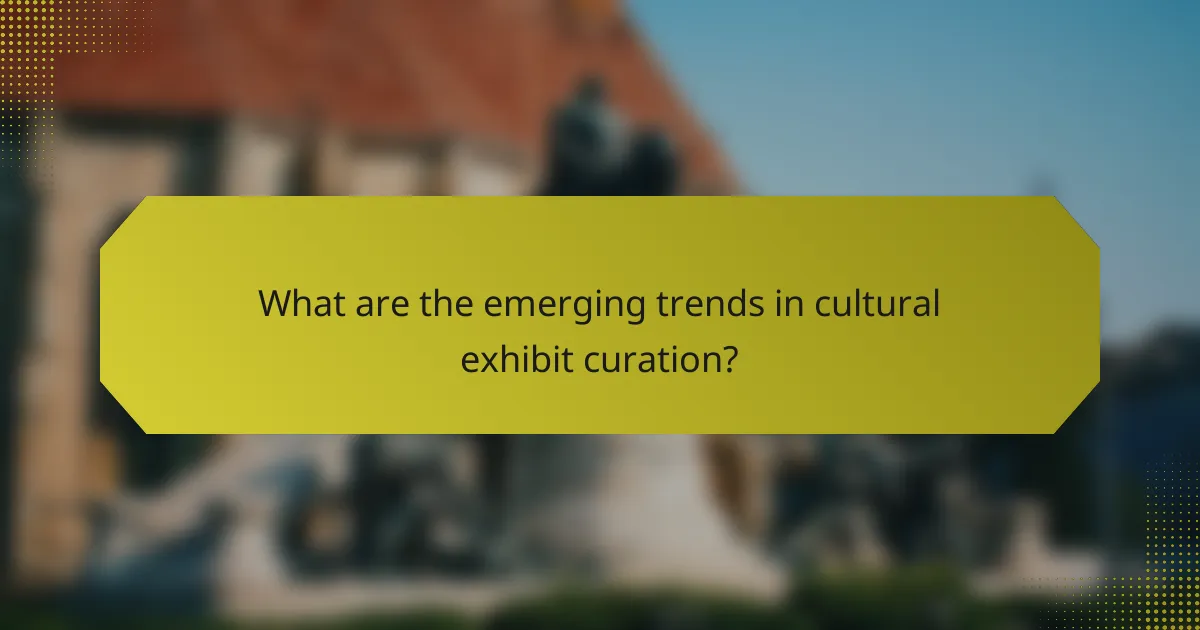Lighting plays a crucial role in shaping the perception of cultural exhibits, enhancing visibility and emotional responses while guiding visitor attention. By employing effective lighting techniques, curators can create an inviting atmosphere that highlights key artifacts and fosters engagement. Additionally, incorporating interactive experiences and multimedia elements further enriches the visitor experience, promoting deeper connections with the exhibit’s content.

How does lighting impact cultural exhibit perception?
Lighting significantly influences how visitors perceive cultural exhibits by enhancing visibility, shaping emotional reactions, and directing attention. Proper lighting can transform the experience, making artifacts more engaging and accessible.
Enhances visual clarity
Effective lighting improves visual clarity by illuminating artifacts and displays, allowing visitors to appreciate details and textures. Brightness levels should be adjusted based on the exhibit’s nature; for example, delicate items may require softer lighting to prevent damage while still being visible.
Using a combination of ambient, task, and accent lighting can create a balanced visual environment. Consider employing LED lights, which offer flexibility in brightness and color temperature, enhancing the overall clarity of the exhibit.
Influences emotional response
Lighting plays a crucial role in shaping visitors’ emotional responses to cultural exhibits. Warm lighting can evoke feelings of comfort and nostalgia, while cooler tones may create a more modern or sterile atmosphere. The choice of lighting color and intensity can significantly affect how visitors connect with the displayed items.
For instance, dramatic lighting can highlight specific pieces, creating a sense of importance and intrigue. Curators should consider the emotional narrative they wish to convey and select lighting that aligns with that vision.
Guides visitor focus
Strategic lighting can guide visitor focus by drawing attention to key exhibits or areas within a cultural space. Spotlights can be used to highlight important artifacts, while softer lighting in the background can minimize distractions and keep the focus on the main displays.
Additionally, using lighting to create pathways or zones within an exhibit can enhance the visitor experience. Clear delineation of spaces through lighting not only improves navigation but also encourages exploration of different sections of the exhibit.

What are effective lighting techniques for exhibits?
Effective lighting techniques for exhibits enhance visibility, create atmosphere, and guide visitor engagement. By using various lighting methods, curators can highlight key pieces while ensuring an inviting environment.
LED lighting for energy efficiency
LED lighting is a popular choice for exhibit curation due to its energy efficiency and long lifespan. These lights consume significantly less power compared to traditional bulbs, which can lead to lower operational costs over time.
When selecting LED fixtures, consider color temperature and brightness to ensure they complement the exhibit’s theme. Look for options that provide adjustable brightness to adapt to different displays and visitor needs.
Spotlighting for focal points
Spotlighting is essential for drawing attention to specific artifacts or displays within an exhibit. By directing light onto focal points, curators can create visual interest and guide visitors’ attention where it is most needed.
Use adjustable spotlights to control the angle and intensity of the light. Position them at a distance that avoids glare while ensuring the highlighted items are clearly visible. This technique can enhance the storytelling aspect of the exhibit.
Ambient lighting for atmosphere
Ambient lighting sets the overall mood of an exhibit, creating a welcoming environment for visitors. This type of lighting should be soft and diffuse, allowing for comfortable navigation without overwhelming the senses.
Consider using wall sconces or ceiling fixtures that provide even illumination throughout the space. Aim for a balance between ambient and task lighting to ensure that all areas of the exhibit are accessible and engaging.

How can visitor engagement be increased in cultural exhibits?
Visitor engagement in cultural exhibits can be significantly enhanced through interactive experiences, storytelling, and multimedia elements. These techniques create a more immersive environment, encouraging deeper connections with the content and increasing visitor satisfaction.
Interactive displays
Interactive displays allow visitors to actively participate in their learning experience, making the exhibit more memorable. Consider incorporating touchscreens, augmented reality, or hands-on activities that relate directly to the exhibit’s theme.
For example, a historical exhibit could feature a touchscreen that lets visitors explore artifacts in greater detail or a virtual reality setup that transports them to a significant historical moment. These engaging elements can boost visitor retention and enjoyment.
Guided tours with storytelling
Guided tours that incorporate storytelling can captivate visitors by providing context and emotional connections to the exhibits. A skilled guide can weave narratives that highlight the significance of artifacts, making the experience more relatable and engaging.
To maximize impact, consider training guides to use anecdotes and personal stories that resonate with diverse audiences. This approach not only enriches the visitor experience but also fosters a sense of community and shared understanding among participants.
Multimedia presentations
Multimedia presentations combine visuals, audio, and interactive elements to create a dynamic learning environment. Utilizing videos, animations, and soundscapes can enhance the storytelling aspect of exhibits, making them more engaging.
When designing multimedia content, ensure it complements the physical displays rather than distracts from them. For instance, a short film about an artist’s life can precede an exhibit of their work, providing context and enriching the visitor’s understanding of the pieces on display.

What criteria should curators consider for exhibit design?
Curators should focus on audience demographics, exhibit theme coherence, and space utilization when designing an exhibit. These criteria help ensure that the exhibit resonates with visitors, maintains a clear narrative, and makes efficient use of available space.
Audience demographics
Understanding the audience demographics is crucial for tailoring the exhibit’s content and presentation style. Factors such as age, cultural background, and interests can significantly influence how visitors engage with the exhibit. For instance, a family-friendly exhibit may incorporate interactive elements, while a more scholarly display might focus on detailed information and historical context.
To effectively address audience demographics, curators can conduct surveys or analyze visitor data from previous exhibits. This information helps in crafting an experience that appeals to the target audience, ensuring higher engagement and satisfaction.
Exhibit theme coherence
Exhibit theme coherence ensures that all elements of the display work together to convey a unified message. Curators should select artifacts, visuals, and narratives that align with the central theme, avoiding any distractions that may confuse visitors. For example, an exhibit on modern art should feature contemporary works and relevant historical context, rather than unrelated pieces.
Maintaining coherence can be achieved through careful planning and regular reviews during the curation process. Curators should ask themselves if each item contributes to the overall theme and if the layout supports the intended narrative flow.
Space utilization
Effective space utilization is essential for creating an inviting and navigable exhibit. Curators should assess the physical layout to ensure that visitors can move comfortably between displays while engaging with the content. This may involve strategic placement of artifacts, signage, and interactive stations to guide the visitor experience.
To optimize space, curators can use techniques such as zoning, where different areas of the exhibit serve distinct purposes, or creating focal points that draw attention. Additionally, considering the flow of foot traffic can help prevent bottlenecks and enhance overall visitor engagement.

What are the emerging trends in cultural exhibit curation?
Emerging trends in cultural exhibit curation focus on enhancing visitor experience through innovative design, technology, and sustainability. Curators are increasingly adopting practices that engage audiences while being mindful of environmental impact and utilizing data to inform decisions.
Sustainability in design
Sustainability in exhibit design emphasizes using eco-friendly materials and practices to minimize environmental impact. Curators are opting for recycled or locally sourced materials, energy-efficient lighting, and sustainable display methods to create exhibits that resonate with environmentally conscious visitors.
Additionally, incorporating natural elements and biophilic design can enhance the visitor experience while promoting a connection to nature. For example, using plants as part of the exhibit can improve air quality and create a calming atmosphere.
Virtual reality experiences
Virtual reality (VR) experiences are transforming how visitors engage with cultural exhibits by offering immersive environments that enhance storytelling. Curators can create simulations that allow visitors to explore historical events or artistic processes in a way that traditional displays cannot achieve.
Implementing VR requires careful consideration of technology accessibility and user experience. Providing headsets and ensuring intuitive navigation can help maximize engagement. Additionally, integrating VR with physical exhibits can create a cohesive experience that deepens understanding.
Data-driven visitor insights
Data-driven insights enable curators to tailor exhibits to visitor preferences and behaviors. By analyzing visitor flow, engagement levels, and feedback, curators can make informed decisions about layout, content, and interactive elements.
Utilizing tools like heat maps and visitor surveys can help identify which areas attract the most attention and which may need improvement. This approach allows for continuous enhancement of the exhibit experience, ensuring it remains relevant and engaging for diverse audiences.

